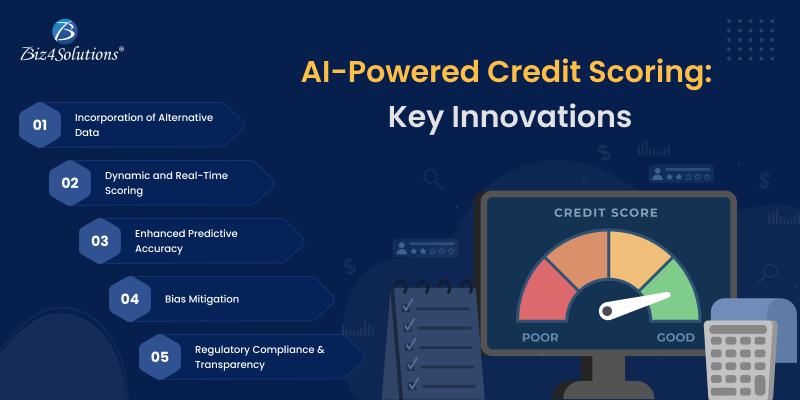The financial services sector is undergoing a paradigm shift, thanks to rapid advancements in Artificial Intelligence. Among the most transformative areas of AI is credit scoring—an essential tool in lending decisions. Traditional credit scoring systems, while functional, are limited by static data, opaque methodologies, and inherent biases. AI is all set to redefine credit scoring by introducing dynamic, inclusive, and transparent Fintech solutions that prove beneficial for both financial institutions and borrowers.
Challenges in Traditional Credit Scoring
Limited Data Sources: Traditional models rely heavily on historical data, such as credit history and repayment records, which can exclude individuals without prior credit.
Bias and Inequity: Standard algorithms often perpetuate systemic biases, proving disadvantageous for underbanked populations.
Static Models: Fixed scoring methodologies fail to account for real-time financial behaviors and changing economic conditions of the end customer.
Transparency Issues: Consumers often find it difficult to understand how their credit score is calculated or improved.
AI-Powered Credit Scoring: Key Innovations

AI addresses the aforementioned limitations by leveraging advanced analytics, alternative data, and machine learning models to deliver smarter and more inclusive credit scoring.
Incorporation of Alternative Data: AI can analyze diverse data points beyond traditional credit reports, such as social media activity, utility and rent payment histories, employment records and cash flow, and behavioral data like spending habits and financial literacy. This widens access to credit for individuals with little to no formal credit history, especially in emerging markets.
Dynamic and Real-Time Scoring: AI models can process data in real time, providing updated creditworthiness evaluations that reflect borrowers’ current financial situations. This flexibility is particularly valuable in volatile economic conditions or for gig workers with fluctuating incomes.
Enhanced Predictive Accuracy: Machine learning algorithms can identify nuanced patterns in borrower behavior, leading to better risk assessment and reduced default rates. This results in more precise lending decisions, benefiting both lenders and borrowers.
Bias Mitigation: AI models, when carefully designed, can actively reduce bias by identifying and removing discriminatory patterns in historical data. Explainable AI (XAI) ensures that credit scoring remains transparent and fair.
Regulatory Compliance and Transparency: AI-powered credit scoring tools can provide detailed reasoning behind each score, helping lenders comply with regulatory requirements and boosting consumer trust.
Use Case Example: AI-based Credit Scoring in Future Banking
Scenario:
Inclusive Lending for Underbanked Populations
Challenge:
A traditional bank faces difficulty assessing the creditworthiness of underbanked individuals, such as freelancers, gig workers, and small business owners. These groups often lack sufficient credit history, leading to the rejection of loan applications despite their potential ability to repay.
Solution:
The bank implements an AI-powered credit scoring system that goes beyond conventional credit data, using a combination of alternative data sources as below:
Transaction behavior: Analysis of spending patterns, savings frequency, and bill payment habits.
Social and behavioral data: Evaluating reliability signals such as online reviews for business owners or platform ratings for gig economy workers.
Income consistency: AI models assess earnings volatility and identify stable income patterns despite irregular cash flow.
AI Implementation:
The banking system continuously learns from new data, refining its scoring models to predict repayment behavior accurately. It uses explainable AI techniques to ensure transparency and compliance with regulatory standards.
Benefits For the Bank:
- Reduced default rates through better predictive analytics.
- Expansion of the customer base by tapping into previously overlooked segments.
- Enhanced risk management and improved decision-making efficiency.
Benefits For Borrowers:
- Fairer loan assessments for individuals without traditional credit histories.
- Faster loan approvals due to automated, real-time evaluations.
- Personalized lending products tailored to their financial behavior.
Best Practices for Responsible AI Implementation in Credit Scoring
Data Privacy: Use of alternative data must comply with stringent privacy laws (e.g., GDPR, CCPA
Model Bias: Continuous monitoring and auditing of AI systems are essential to ensure fairness.
Over-Reliance on Automation: Human oversight is necessary to validate AI-driven decisions.
Looking Ahead into The Future of AI in Credit Scoring
The AI-based credit scoring system not only modernizes lending but also promotes financial inclusion by creating equitable opportunities for credit access. And, despite being in the nascent stages such systems are gaining traction globally. Nevertheless, emerging AI trends promise to reshape the future of credit scoring by making it more inclusive, accurate, and transparent. As fintech innovators and banks continue to invest in AI-driven software development, they unlock opportunities for smarter lending practices that drive financial empowerment. While challenges remain, the potential benefits far outweigh the risks, paving the way for a more equitable and efficient financial ecosystem.
